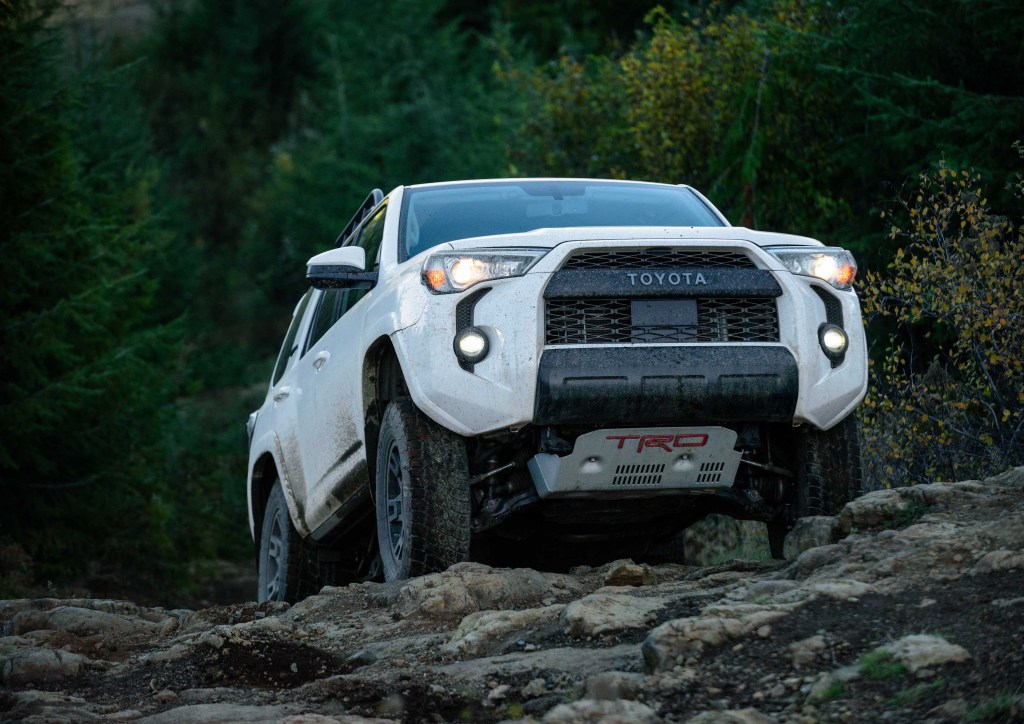
The One Toyota 4Runner Model Year to Avoid
The Toyota 4Runner has an almost legendary reputation for reliability, especially within Consumer Reports. Models regularly see 200,000 or more miles, due in part to the SUV’s old-school design. While the off-road-focused TRD Pro models command a premium, many fairly-new 4Runners can be bought for under $20,000. However, as with the Toyota Tacoma, there are a few chinks in the 4Runner’s reliability history. Those shopping for a used Toyota 4Runner should avoid the 2003 model year in particular.
The #1 reason you should avoid the 2003 Toyota 4Runner: rust
CarComplaints.com ranks the 2003 Toyota 4Runner as the worst model year in the site’s records. That’s mostly due to the sheer volume of 2003 4Runner rust issues. In fact, it’s CarComplaints.com’s #1 Toyota 4Runner problem over every model year.
Running any vehicle, SUV or not, in snowy conditions—especially in places where the roads are salted—can raise the risk of rust. But, with regular washes and care, it’s not necessarily something to worry about. But with the 2003 4Runner, that’s another story.
Owners have reported holes in the frame, entire welds and even transmission mounts rusted away. Reading through the complaints, “unsafe to drive” appears over and over again. CarComplaints.com claims the average repair cost is $1400, but some owners have quoted repair bills as high as $15,000. The site also reported that the complains were so numerous and severe, that the NHTSA had opened an official investigation. As of writing, the investigation is currently pending.
This wouldn’t be the first time Toyota had rust issues. The Tacoma, Tundra, and Sequoia were all part of a lawsuit that led to Toyota the vehicles’ rusted frames. The model years ranged from 2005-2010, making the 2003 4Runner’s rust issues oddly coincidental. And according to Forbes, 4Runner owners are gearing up for their own class-action lawsuit.
Other problems with the 2003 Toyota 4Runner
The excessive rust issue with the 2003 Toyota 4Runner is by far the most dangerous and expensive problem, but that isn’t this model year’s only one.
CarComplaints.com also reports issues with the 2003 Toyota 4Runner’s brakes. Owners complained of brakes failing, and front calipers locking up. Consumer Reports also reported numerous complaints of’03 4Runners with seized-up front calipers, with the problem returning even after the calipers had been replaced or serviced. This is the #3 issue with the 2003 Toyota 4Runner on CarComplaints.com.
Something that would appear merely a minor headache, but could actually be much worse, was the 2003 Toyota 4Runner’s #2 issue: cracked and melting dashboards. ToyotaProblems.com reports the issue is worse in areas of high humidity and heat. Although, CarComplaints.com lists one owner claiming to live on a tropical island, whose 4Runner’s dash only cracked after the windows were tinted. UV exposure, then, appears to not be the only cause.
The cracks weren’t the only cosmetic or structural issue. Dashboards would melt, and ooze some kind of sticky goo. In addition to potentially blinding drivers from the shine, owners were worried the airbags would be affected by the melted plastic. The problem got so bad, Toyota-4Runner.org reports, Toyota issued a recall.
Other problematic Toyota 4Runner model years
The dashboard recall didn’t only pertain to the 2003 Toyota 4Runner. The 2004 and 2005 MY 4Runners were also included in this recall. In fact, a cracked and melted dashboard is the most common 2004 Toyota 4Runner complaint.
The 2004 and 2005 4Runners also experienced many of the same issues as the 2003 model. Not just excessive rust, but also failing clear coat and fading paint, too. Again, problems the 2007 Tacoma also experienced. The ’04 and ’05 4Runners also had similar front brake caliper issues, with one Toyota-4Runner.org forum member claiming to be on their 3rd set.
According to CarComplaints.com, the 2004 Toyota 4Runner actually has more complaints than the 2003 model, but the ’03 model’s problems are more severe and expensive. In addition to all the other issues, Consumer Reports ranked the 2004 4Runner low in engine and exhaust reliability, because of how frequently owners had to replace catalytic converters and oxygen sensors.
Have these issues been resolved?
Yes, it appears so. Although the 2003 Toyota 4Runner’s rust issues are the #1 problem on CarComplaints.com, the #2 issue comes from the 2015 model’s use of Takata airbags. Those have been recalled, and are not solely a Toyota issue, but an industry issue.

Another such issue is the 2016 4Runner’s seemingly rodent-attracting wiring. CarComplaints lists it as the #3 4Runner problem, with one owner claiming rodents are attracted to the SUV’s soy-based wiring. Although The Drive reported that, yes, Toyota used soy-based wiring in its vehicles, the company claimed such wiring isn’t inherently more appealing to rodents. And much like the Takata airbags, Toyota isn’t the only automaker to use this kind of wiring.


